1. Introduction
Behavior problems related to anxiety are very common in dogs [1]. These include separation anxiety, which is described as excessive vocalization, destruction, urination, defecation, repetitive motor activity and self-injury when left alone. Decreased quality of life is reported for both dogs and owners can also be negatively impacted, in addition the physical health of the dogs can be negatively impacted [1]. When any animal (humans included) is exposed to an anxiety provoking stimulus, a physiological stress response occurs. This stress response is thought to have both short-term and long- term effects on health and lifespan of the individual [2,3]. Studies of US animal shelters consistently indicate that problem behavior is often a main reason for relinquishment and euthanasia of dogs [4]. Given these risks it is important to ease the distress of dogs with separation anxiety for its welfare. Salman et al. [5] found that the primary reason for dog abandonment is perceived behavior problems.
There is evidence that the severity of the anxiety response in dogs is related to how attached the dog is to the owner. Anxious dogs may show more attachment behaviors than less anxious dogs [6]. It is the owner’s response to separation of dog with owner that can result in in disrupted and negative behaviors. Current owner behavior may reflect current work practices, our lifestyles: long working hours, one and only owner, limited social times with other dogs and less exercise. It is difficult for dog owners to change their environment and daily routine. Dogs living in human society have to adapt to the pattern of their human partners.
Treatments for anxiety have followed the patter identified for human patients. Pharmaceutical interventions for anxiety are regularly prescribed, with evidence suggesting that they can provide effective medical treatments for separation anxiety [7]. For example, tricyclic antidepressant (TCA) medication for human with anxiety disorders such as clomipramine are also useful for dogs with separation anxiety. Although dogs that treated with medication do show reductions in problem behaviors, unwanted side effects, such as lethargy, ataxia, paradoxic excitement and vomiting, are reported by the dog owners which increasing hesitancy to medicate their dogs [8]. Behavior therapy offers an alternative that may target both symptoms and underlying causal mechanisms unlike the use of drugs. This work aims to contribute to a deeper understanding of behavioral learning association in the treatment of separation anxiety.
2. Environmental Causes Related to Separation Anxiety
Given that behavioral problems are one of the main reasons that pet dogs being relinquished [4], understanding the environmental factors that contribute to separation anxiety may allow for physical and environmental changes. Researchers have investigated the environmental factors that associated with separation anxiety and found that dogs with separation anxiety exercised less compared with dogs that did not have separation anxiety [9]. Although the dogs that show separation anxiety behavior signs are mixed-breed dogs from shelters, purebred dogs that have lived in the same home all their lives may encounter this problem as well [10].
Researchers suggest that the causal factors for separation anxiety is the dog’s hyperattachment to the owner [11]. Attachment is the process of psychological and behavioral alignment between a dog and owner that generates a lasting bond that is proposed to affect the dog’s emotional state and contribute to calmed behavior. During extended home stays, for example during the pandemic of Covid-19, the dog may show separation anxiety behavior signs when the owner goes back to work. Meanwhile some researchers found that hyperattachment is not a necessary factor for separation anxiety. Not all dogs that are treated as family members or encouraged to have a close relationship with their owners have separation anxiety related problems.
Another factor that may cause separation anxiety is a dramatic change in the owner and dog’s daily life related to changes in working patterns as longer working hours or moving to a new living space. The appearance of separation anxiety is clearly correlated with any experienced event or stimulus which can be learned as signals of the impending and actual absence of the owner. For example, dogs can anticipate their owner’s departure, such signals as putting on make-ups, picking up keys, putting on coat or shoes, and turning off the lights. These cues can be a trigger to a dog’s anxiety response. Usually, the separation anxiety related behaviors reach a peak intensity shortly after the owner’s departure [12]. Dogs with separation related problems also get overly excited when their owners come back home, which can also generate unwanted behaviors. Stephen and Ledger [13] found that there are high correlations between ratings of separation anxiety given by the same dog’s former owner who relinquished their dogs to shelters and the new owners. It means that it is not attachment to a particular human that is the problem for these dogs, but a problem that the dogs take with them to new homes. It is humans that active all the cues of separation anxiety but not a particular human. The correlation between ratings provided by former and new owners of the same dog for separation anxiety was higher than for any other dog behavior problems [13]. Rehoming dogs are unlikely to alleviate the separation-related problem unless some treatment is received.
3. Medication Treatment for Separation Anxiety
Tricyclic antidepressant medicine used to treat humans (e.g., clomipramine, fluoxetine and diazepam) to treat depression and anxiety are approved by the US Food and Drug Administration for the treatment of separation anxiety in dogs [14].
Clomipramine is approved in the United States for treatment of dogs. King J.N. et al have conducted a double-blind, placebo-controlled clinical trial to test the efficacy and tolerability of clomipramine in the treatment of separation anxiety in dogs [7]. The result indicated that dogs receiving standard-dose clomipramine were improved at least three times faster compared to placebo. The signs of separation anxiety such as destruction, defecation and urination were decreased, but the differences between the standard dose and the placebo groups in vocalization is not significant. Mild and transient vomiting was reported as a side effect in a small number of dogs [15].
Fluoxetine has also been investigated and demonstrated to improve separation-related behaviors of dogs when compared to dogs treated with a placebo [16]. A combination of fluoxetine and clorazepate dipotassium was found to decrease the signs of anxiety in dogs [17]. However, adverse side effects were reported by the dog owners. Landsberg et al [8] have found that dogs treated with fluoxetine presented lethargy or depression, and apparently more dogs who received fluoxetine experienced a loss of appetite compared with dogs who received a placebo.
Finally, the anxiolytic diazepam, one of benzodiazepine drug is used by humans to treat panic and anxiety disorders. As veterinary behavioral medicine, diazepam is used in the treatment of separation anxiety, fear of thunderstorms or loud noises, and other fear or anxiety-related problems in dogs [18]. Herron et al [18] found that more than half of the owners in their study reported diazepam is effective with their dogs who have separation anxiety. However, adverse effects are also reported by about half of the owners, including ataxia, undesirable or excessive sedation, increased appetite, paradoxic excitation, or agitation.
4. Behavioral Treatment for Separation Anxiety
In spite of the success of medicines, behavioral modifications provide a more successful and safer treatment pathway for affected dogs. The specific objective of this research is to emphasize the importance of behavioral modifications in the treatment of separation anxiety in dogs. Behavior theory assumes that anxiety is acquired and learned and that behavioral treatments involving desensitization and counterconditioning are effective tools that can be applied with support from a Behavioral Mental Health trainer (BMHT) and the owner. Butler et al [19] found a study of desensitization and counterconditioning which showed that they are effective for dogs with separation related behaviors even though the treatment procedure was conducted by the dog owners.
Here a new treatment method is proposed based on associative learning in response to dogs’ separation anxiety with a ten-year record in supporting China’s pet dogs. A total of 129 dogs (71 males [55%], 58 females [45%]) with separation anxiety came to the author. The owners complained that the dogs’ problem behaviors such as vocalization, pacing, inappropriate elimination, destruction, etc. had lasted more than half a year, and the frequency, intensity and duration of behavior increased to varying degrees. During the initial assessment, we record the problem behaviors of the dog via a camera, for example the pacing duration and barking duration after the owner left. Usually, these data will be recorded for one week to obtain the average value or interval value. Following treatment, the data can be compared with post treatment behavior to assess effectiveness. A detailed example plan can be found in the Appendix. Using this method resulted in 100% effectiveness, all the affected dogs had cessation or decreased problem behaviors after 1-6 months’ treatment in contrast with the initial assessment. Table1 shows the treatment effects of different behavior signs.
Table 1:Treatment outcome obtained via assessment after 1-6 months’ treatment in contrast with the initial assessment.
Behaviors | Number | Complete cessation | Reduced |
Vocalization | 124 | 65% | 35% |
Elimination | 33 | 91% | 9% |
Destruction | 68 | 75% | 25% |
Pacing | 114 | 55% | 45% |
Here is a case which shown the whole details of treatment.
Case: A Weimaraner with separation anxiety
Breed: Weimaraner
Age: 2
Sex: male
Sterilization: sterilized at 13 months
Age obtained: 4 months
Age at onset: 6 months
Socialization level: (Worse, Bad, Normal, Good, Great)
Social with other dogs ----- Good
Social with human ----- Good
Adaptability to environmental changes ----- Normal
Adaptability to sudden sound ----- Bad
4.1. Owner's Statement
Since the dog was about 6 months old, it stayed at home alone when the owner went to work and the dog began to bark, accompanied by pacing. This situation continued till they came for treatment. The barking sound was getting louder and louder, and the duration had changed from 1 hour to 4-5 hours. The cumulative duration of pacing was about 2-3 hours. There were no other problems such as house destruction or inappropriate excretion.
4.2. Assessment
We recorded the cumulative duration of barking and pacing after the owner left home for a week via camera. Figure 1 shows the record of barking, while Figure 2 shows the record of packing. After that, the affected dog began to receive treatment. As shown in Figure 3, the treatment was in three aspects.
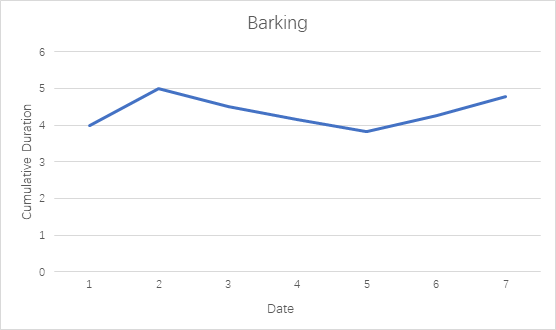
Figure 1:Cumulative duration of barking in 7days.
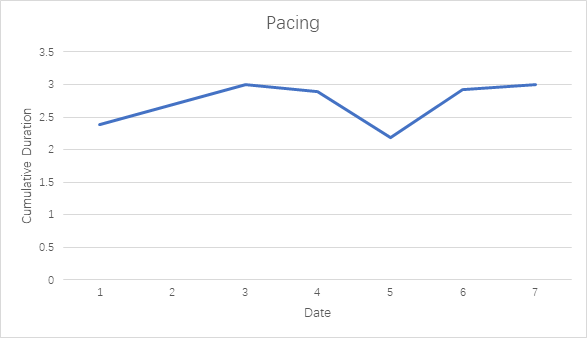
Figure 2:Cumulative duration of pacing in 7days.
Figure 3: Steps of treatment in three aspects.
4.3. Closing Report
The total treatment and training time of the dog was 3 months, including stay and other training contents. After the treatment, we recorded the dog’s performance again through the camera after the owner left. Figure 4 shows the comparison of barking before and after treatment and Figure 5 shows the comparison of pacing before and after treatment. By comparing the following data with the initial data at the time of assessment, it was obvious that the treatment was effective and successful.
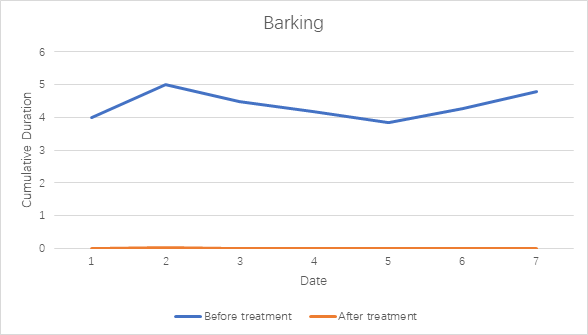
Figure 4: Comparison of barking before and after treatment.
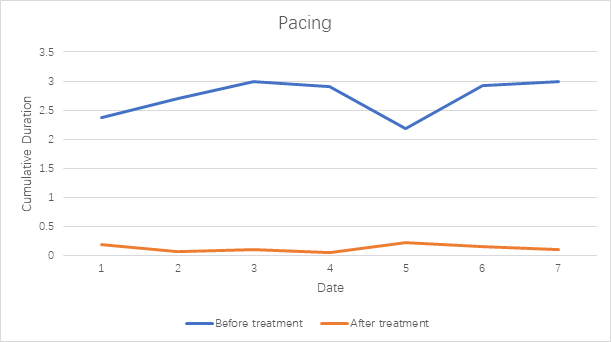
Figure 5: Comparison of pacing before and after treatment.
Many dogs with separation anxiety show the same behavior, which is when the owner takes a bath in the bathroom or the dog is not in the same room with the owner, it will not present any separation-related behaviors. The reason is that they sense that the owner is nearby or behind the door. That is their vision, auditory and olfactory, which are three of the five senses, perceiving the presence of their owners. It can see whether the owner is at home through vision; it can hear whether the owner has left home when the owner is not in sight through hearing; it can judge whether the owner is far away from it by smelling the concentration of the owner's body odor. These are the classical conditioned reflexes learned without explicit training by the owners under natural conditions, which is a form of association learning. We can also use this method of association learning to establish new associations and diminish the behaviors. The treatment is to change an association from each sense modality vision, hearing, and smell. The preparation work should start with three foci based around the senses, we call this Sense Focused Therapy (SFT).
4.4. Vision
During treatment, it is suggested that the owner limits the affected dog’s daily activities to a defined area such as a room or a part of living room, which may differ according to different situations of families for approximately 70-80% time of a day. For example, the owner can choose an independent room for it and install a dog gate, but it would be the best if the dog does not see the door of the house directly in this room. The goal is to change the dog’s association between the sound of opening and closing the door of the house and the owner’s departure, namely, the dog no longer perceives the sound of opening and closing the door as the signal of the own’s departure. Figure 6 shows an example of how dog owners can organize their home.
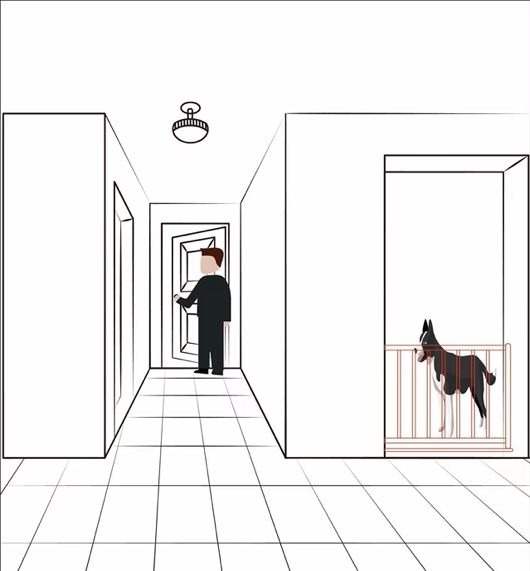
Figure 6 - The dog was kept in a room with a dog gate where it can see the owner through the gate but cannot see the door of the house. The dog does not know whether the owner has left.
If the dog cannot be alone in the fenced area when the owner is at home, it may need to be trained to stay alone first. For example, use a dog gate to prevent the dog from following the owner everywhere at home. Since the dog can see the owner through the gate, the dog will not get anxious easily compared to using a closed door. Because of the fence, the dog can't see and determine whether the owner really leaves while it can know it through hearing. The dog used to hear the sound of opening and closing the door (CS, conditioned stimulus) and repeatedly paired with the owner’s departure (US, unconditioned stimulus). The sound of opening and closing the door is the cue of the owner’s departure. Now this association has been changed. The owner deliberately opens and closes the door (CS appears), and then deliberately makes a sound to let the dog know that the owner is at home (US does not appear). Repeat this procedure several times and the dog will no longer take opening and closing the door as a signal for the owner’s departure. The former association has been weakened.
4.5. Hearing
The owner can buy a high-fidelity sound receiving microphone to record the owner's voice during the day at home. This may include the voice of cleaning the room, playing games, playing music, talking with friends on the phone, and even snoring when sleeping. When the owner is at home, keep playing the recorded sound of daily life (CS appears) and often show up in the dog’s sight (US appears). The dog will be relaxed at home as usual, such as sleeping, playing toys, etc. (CR, conditioned response). When the owner occasionally leaves home, the dog doesn’t think the owner has left because will not perceive that the owner has left because of the sound that playing (CS appears), so it will sleep or play toys as usual (CR).
4.6. Smell
The owner needs to prepare several clothes that worn during sports. Don't wash them. There is a strong smell of the owner on them.In the case of visual shielding, the dog can only rely on hearing and smell. The owner can put the worn clothes next to the fence but out of the dog’s sight. The smell of the owner (CS appears) indicates that the owner is nearby (CR) is a natural conditioned reflex that formed in daily life (Naturally-arising classical conditioning).
By shielding the visual signal and changing the association learning of auditory signal and olfactory signal, the dog does not know when the owner will leave or come back. According to our application in actual cases, this treatment is effective and successful for most dogs with separation anxiety. However, it needs to be slightly adjusted to the specific situation and family environment of dogs.
In the treatment, if the dog is anxious as soon as the owner leaves its sight, for example, the owner is in the bathroom or other rooms, the dog will also be anxious. In this case when using this treatment plan, the owner needs to carry out "stay" training first. For instance, the owner is in the dog’s sight and lets the dog stay on its own mat with increasing the time step by step. It is a good choice to use food as a reward. When the dog can be maintained for more than ten minutes, the owner can try to walk away and disappear for a few seconds and then reappear in its sight. In practice, dog owners should leave the dog for very short times in the beginning, returning very quickly, and gradually increasing the length of their absences. When the dog can keep a certain distance from the owner and stay alone for a few hours at home, then the further procedure can be carried out.
During the procedure that the owner may leave and return with the daily life sound playing, this may be only a few minutes at the beginning and gradually extend to a few hours. The owner should be as natural as always when comes back home and reappears in the dog’s sight as if he/she never leaves or just like getting a delivery from the door so that the dog will not feel cheated.
5. Conclusion
Separation anxiety is the main reason that the dog and owner experience distress and pressure. It is also the main reason that pet dogs are being relinquished or even euthanized. Only if the dog owners find the appropriate interventions, or the dogs will keep the problem with them even they go to a new family [20]. It is difficult for the owners to prevent the onset of separation anxiety, but they can eliminate the problem through behavioral modification plans or combine with medication. Although there are many studies about the effectiveness of the medication for separation anxiety in dogs, the adverse side effects disturb the dog owners. Compared to medication, behavioral modification is more effective and safer for affected dogs. More studies are needed to isolate the factors predispose dogs to separation anxiety. It would be helpful to examine the separate effects of behavioral modifications in the presence and absence of pharmacological interventions [20].
The whole picture of separation anxiety in dogs is shrouded in mystery. Besides the medical and behavioral research, the underlying explanation of cognitive neuroscience about separation anxiety in dogs is needed. This is also the new field which the author wants to explore for it is believed that brain, as a behavior command, must have a lot to do with many problem behaviors.
China has a large quantity of pet dogs, thus there are many dogs have behavior problems. Although the method proposed by the author is effective and successful, there is only one person to carry it out which makes it difficult to get more and more dogs cured. It is hoped that domestic and abroad dog trainers, who have read this article and learned this method, can get more dogs treated to avoid the unnecessary anxiety and distress caused by homelife triggers.
References
[1]. Dreschel, N., (2010) The effects of fear and anxiety on health and lifespan in pet dogs, Applied Animal Behaviour Science, 125: 157-162.
[2]. Chrousos, G.P., Gold, P.W., (1992) The concepts of stress and stress system disorders. Overview of physical and behavioral homeostasis. 267(9):1244-1252.
[3]. McEwen, B.S., (2005). Stressed or stressed out: what is the difference? J. Psychiatr. Neurosci. 30: 315–318.
[4]. Kogan L.R., Hellyer P.W., Rishniw M., Schoenfeld-Tacher R..(2020) Veterinary Behavior: Assessment of Veterinarians' Training, Experience, and Comfort Level with Cases. J. Vet Med Educ. 47(2):158-169.
[5]. Salman, M., Hutchison, J., Ruch-Gallie R.. (2000) Behavioral reasons for relinquishment of dogs and cats to 12 shelters. J. Appl. Anim. Welf. Sci. 3: 93-106.
[6]. Topál J., Miklósi A., Csányi V., Dóka A.. (1998) Attachment behaviour in dogs (Canis familiaris): a new application of Ainsworth’s. Strange Situation Test. J Comp Psychol. 112(3):219–229.
[7]. King, J.N., Simpson, B.S., Overall, K.L., Appleby, D., Pageat, P., Ross, C., Chaurand, J.P., Heath, S., Beata, C., Weiss, A.B., Muller, G., Paris, T., Bataille, B.G., Parker, J., Petit, S., Wren, J.. (2000) Treatment of separation anxiety in dogs with clomipramine: results from a prospective, randomized, double-blind, placebo-controlled, parallel-group, multicenter clinical trial. Appl Anim Behav Sci. 67(4):255-275.
[8]. Herron, M.E., Shofer, F.S., Reisner, I.R.. (2008) Retrospective evaluation of the effects of diazepam in dogs with anxiety-related behavior problems. J Am Vet Med Assoc. 233(9):1420-1424.
[9]. Tiira, K., Lohi, H.. (2015) Early life experiences and exercise associate with canine anxieties. PloS ONE. 10(11): e0141907
[10]. Simpson, B.S., (1998). Canine separation anxiety. Contin. Educ. Vet. Tech. and Staff: Expo 98: 66-70.
[11]. Takeuchi, Y., Houpt, K.A., Scarlett, J.M., (2000). Evaluation of treatments for separation anxiety in dogs. JAVMA 217: 342-345.
[12]. Lund, J.D., Jørgensen, M.C.. (1996) Behaviour patterns and time course of activity in dogs with separation problems. Appl Anim Behav Sci. 63(3):219–236.
[13]. Stephen, J., Ledger, R.. (2007) Relinquishing dog owners’ ability to predict behavioural problems in shelter dogs post adoption. Appl Anim Behav Sci. 107(1–2):88–99.
[14]. Cannas, S., Frank, D., Minero, M., Aspesi, A., Benedetti, R., Palestrini, C.. (2014) Video analysis of dogs suffering from anxiety when left home alone and treated with clomipramine. J Vet Behav. 9(2):50–57.
[15]. Gaultier, E., Bonnafous, L., Bougrat, L., Lafont, C., Pageat, P.. (2005) Comparison of the efficacy of a synthetic dog-appeasing pheromone with clomipramine for the treatment of separation-related disorders in dogs. Vet Rec. 156(17):533-8.
[16]. Simpson, B.S., Landsberg, G.M., Reisner, I.R.. (2007) Effects of reconcile (fluoxetine) chewable tablets plus behaviour management for canine separation anxiety. Vet. 8(1):18–31.
[17]. Pineda, S., Anzola, B., Olivares, A., Ibáñez, M.. (2014) Fluoxetine combined with clorazepate dipotassium and behaviour modification for treatment of anxiety-related disorders in dogs. Vet J. 199(3):387–391.
[18]. Landsberg, G.M., Melese, P., Sherman, B.L., Neilson, J.C., Zimmerman, A., Clarke, T.P.. (2008) Effectiveness of fluoxetine chewable tablets in the treatment of canine separation anxiety. J Vet Behav. 3(1):12–19.
[19]. Butler, R., Sargisson, R.J., Elliffe, D.. (2010). The efficacy of systematic desensitization for treating the separation-related problem behaviour of domestic dogs. Appl Anim Behav Sci. 129(24):136–145.
[20]. Stephen, J., Ledger, R.. (2007) Relinquishing dog owners’ ability to predict behavioural problems in shelter dogs post adoption. Appl Anim Behav Sci. 107(1–2):88–99.
Cite this article
Yi,T. (2023). A More Effective and Safer Treatment of Separation Anxiety. Lecture Notes in Education Psychology and Public Media,3,121-130.
Data availability
The datasets used and/or analyzed during the current study will be available from the authors upon reasonable request.
Disclaimer/Publisher's Note
The statements, opinions and data contained in all publications are solely those of the individual author(s) and contributor(s) and not of EWA Publishing and/or the editor(s). EWA Publishing and/or the editor(s) disclaim responsibility for any injury to people or property resulting from any ideas, methods, instructions or products referred to in the content.
About volume
Volume title: Proceedings of the 3rd International Conference on Educational Innovation and Philosophical Inquiries (ICEIPI 2022), Part II
© 2024 by the author(s). Licensee EWA Publishing, Oxford, UK. This article is an open access article distributed under the terms and
conditions of the Creative Commons Attribution (CC BY) license. Authors who
publish this series agree to the following terms:
1. Authors retain copyright and grant the series right of first publication with the work simultaneously licensed under a Creative Commons
Attribution License that allows others to share the work with an acknowledgment of the work's authorship and initial publication in this
series.
2. Authors are able to enter into separate, additional contractual arrangements for the non-exclusive distribution of the series's published
version of the work (e.g., post it to an institutional repository or publish it in a book), with an acknowledgment of its initial
publication in this series.
3. Authors are permitted and encouraged to post their work online (e.g., in institutional repositories or on their website) prior to and
during the submission process, as it can lead to productive exchanges, as well as earlier and greater citation of published work (See
Open access policy for details).
References
[1]. Dreschel, N., (2010) The effects of fear and anxiety on health and lifespan in pet dogs, Applied Animal Behaviour Science, 125: 157-162.
[2]. Chrousos, G.P., Gold, P.W., (1992) The concepts of stress and stress system disorders. Overview of physical and behavioral homeostasis. 267(9):1244-1252.
[3]. McEwen, B.S., (2005). Stressed or stressed out: what is the difference? J. Psychiatr. Neurosci. 30: 315–318.
[4]. Kogan L.R., Hellyer P.W., Rishniw M., Schoenfeld-Tacher R..(2020) Veterinary Behavior: Assessment of Veterinarians' Training, Experience, and Comfort Level with Cases. J. Vet Med Educ. 47(2):158-169.
[5]. Salman, M., Hutchison, J., Ruch-Gallie R.. (2000) Behavioral reasons for relinquishment of dogs and cats to 12 shelters. J. Appl. Anim. Welf. Sci. 3: 93-106.
[6]. Topál J., Miklósi A., Csányi V., Dóka A.. (1998) Attachment behaviour in dogs (Canis familiaris): a new application of Ainsworth’s. Strange Situation Test. J Comp Psychol. 112(3):219–229.
[7]. King, J.N., Simpson, B.S., Overall, K.L., Appleby, D., Pageat, P., Ross, C., Chaurand, J.P., Heath, S., Beata, C., Weiss, A.B., Muller, G., Paris, T., Bataille, B.G., Parker, J., Petit, S., Wren, J.. (2000) Treatment of separation anxiety in dogs with clomipramine: results from a prospective, randomized, double-blind, placebo-controlled, parallel-group, multicenter clinical trial. Appl Anim Behav Sci. 67(4):255-275.
[8]. Herron, M.E., Shofer, F.S., Reisner, I.R.. (2008) Retrospective evaluation of the effects of diazepam in dogs with anxiety-related behavior problems. J Am Vet Med Assoc. 233(9):1420-1424.
[9]. Tiira, K., Lohi, H.. (2015) Early life experiences and exercise associate with canine anxieties. PloS ONE. 10(11): e0141907
[10]. Simpson, B.S., (1998). Canine separation anxiety. Contin. Educ. Vet. Tech. and Staff: Expo 98: 66-70.
[11]. Takeuchi, Y., Houpt, K.A., Scarlett, J.M., (2000). Evaluation of treatments for separation anxiety in dogs. JAVMA 217: 342-345.
[12]. Lund, J.D., Jørgensen, M.C.. (1996) Behaviour patterns and time course of activity in dogs with separation problems. Appl Anim Behav Sci. 63(3):219–236.
[13]. Stephen, J., Ledger, R.. (2007) Relinquishing dog owners’ ability to predict behavioural problems in shelter dogs post adoption. Appl Anim Behav Sci. 107(1–2):88–99.
[14]. Cannas, S., Frank, D., Minero, M., Aspesi, A., Benedetti, R., Palestrini, C.. (2014) Video analysis of dogs suffering from anxiety when left home alone and treated with clomipramine. J Vet Behav. 9(2):50–57.
[15]. Gaultier, E., Bonnafous, L., Bougrat, L., Lafont, C., Pageat, P.. (2005) Comparison of the efficacy of a synthetic dog-appeasing pheromone with clomipramine for the treatment of separation-related disorders in dogs. Vet Rec. 156(17):533-8.
[16]. Simpson, B.S., Landsberg, G.M., Reisner, I.R.. (2007) Effects of reconcile (fluoxetine) chewable tablets plus behaviour management for canine separation anxiety. Vet. 8(1):18–31.
[17]. Pineda, S., Anzola, B., Olivares, A., Ibáñez, M.. (2014) Fluoxetine combined with clorazepate dipotassium and behaviour modification for treatment of anxiety-related disorders in dogs. Vet J. 199(3):387–391.
[18]. Landsberg, G.M., Melese, P., Sherman, B.L., Neilson, J.C., Zimmerman, A., Clarke, T.P.. (2008) Effectiveness of fluoxetine chewable tablets in the treatment of canine separation anxiety. J Vet Behav. 3(1):12–19.
[19]. Butler, R., Sargisson, R.J., Elliffe, D.. (2010). The efficacy of systematic desensitization for treating the separation-related problem behaviour of domestic dogs. Appl Anim Behav Sci. 129(24):136–145.
[20]. Stephen, J., Ledger, R.. (2007) Relinquishing dog owners’ ability to predict behavioural problems in shelter dogs post adoption. Appl Anim Behav Sci. 107(1–2):88–99.









